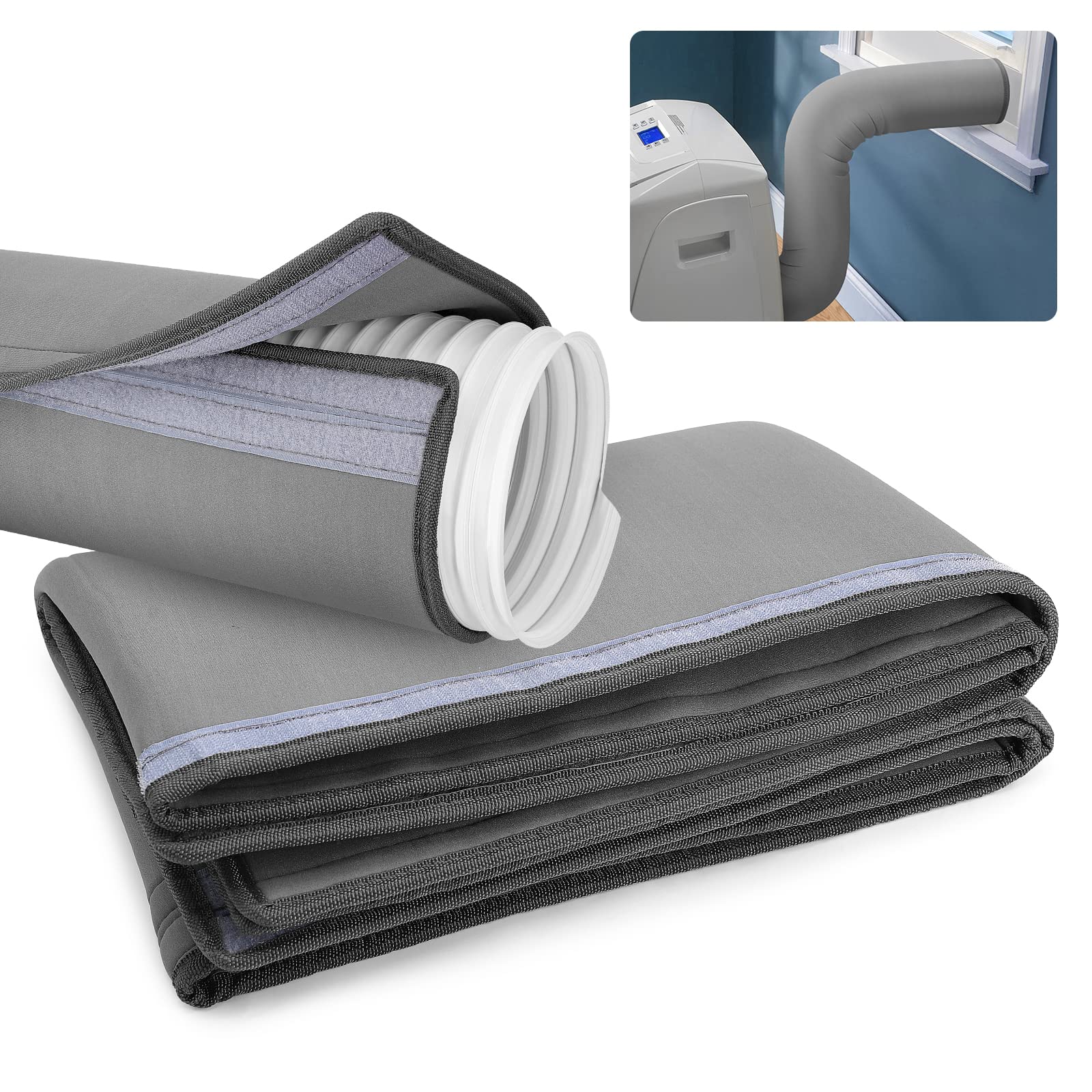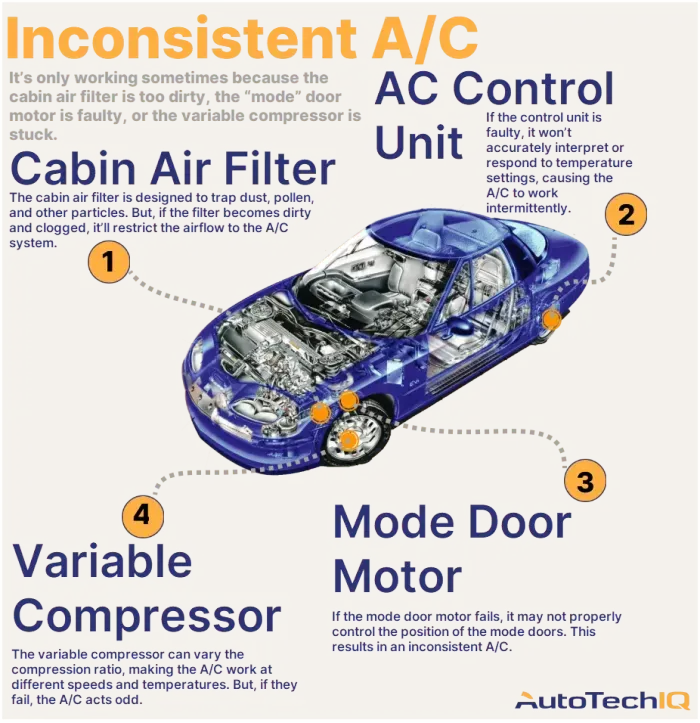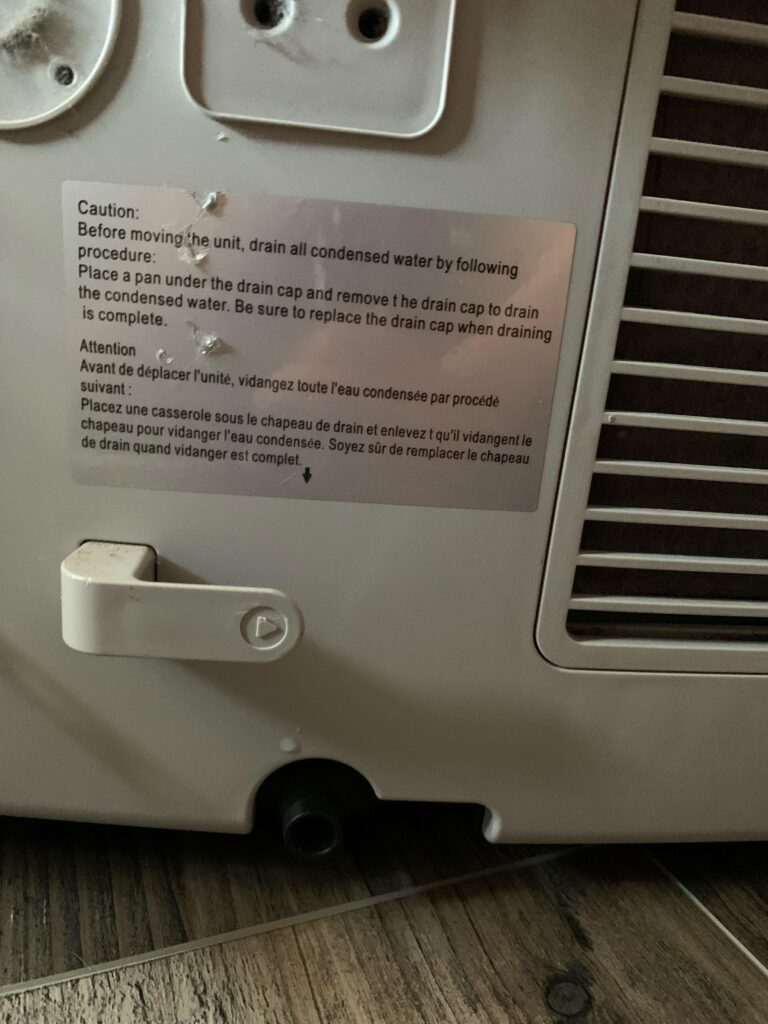How to Insulate Portable AC Hose: A Complete Guide
To insulate a portable AC hose, you can use pipe insulation, wrap the hose in duct tape, use a foam tube or sleeve, or use a specifically made covering for air conditioner hoses. Insulating the hose helps keep cool air in and prevent heat loss, maintaining the temperature within the exhaust-ducting and preventing re-entry of heat into the room you are trying to cool.
Using materials such as polyethylene foam or foam rubber insulators can effectively insulate the AC pipes. Additionally, foil tape or electrical tape, a utility knife, and scissors may be needed for installation. Insulating the AC lines helps improve the efficiency and performance of the portable AC unit.

Credit: cielowigle.com
Why Insulating Your Portable Ac Hose Is Important
Insulating your portable AC hose is important for maintaining the temperature inside the exhaust-ducting and preventing heat loss. Some effective ways to insulate the hose include using pipe insulation, wrapping it in duct tape, using a foam tube or sleeve, or using a covering specifically designed for air conditioner hoses.
By insulating the hose, you can ensure that the cool air remains inside and prevent the re-entry of heat into the room you are trying to cool.
Energy Efficiency And Cost Savings:
- Insulating your portable AC hose can significantly improve energy efficiency, leading to cost savings on your energy bills.
- By preventing heat loss, insulation helps your portable AC unit cool the room more efficiently, allowing it to run for shorter periods and consume less power.
- Insulation also helps to maintain the cool air inside the room and prevents warm air from entering, reducing the workload on your AC unit and saving energy.
Improved Cooling Performance:
- Insulating your portable AC hose can enhance the cooling performance of the unit by minimizing heat transfer from the hot exhaust air.
- Insulation acts as a barrier, preventing the hose from absorbing heat from its surroundings, resulting in cooler air being expelled from the unit.
- With improved cooling performance, your portable AC unit can effectively cool the room, providing a more comfortable environment during hot summer days.
Preventing Heat Loss And Condensation:
- Insulating your portable AC hose helps to prevent heat loss during the exhaust process.
- Heat loss occurs when the hot air from the exhaust hose comes into contact with cooler surfaces, lowering its temperature before it is expelled.
- Insulation also helps to prevent condensation from forming on the hose, which can lead to moisture damage and reduced efficiency of the AC unit.
- By insulating the hose, you can minimize heat loss and prevent condensation, ensuring optimal performance and longevity of your portable AC unit.
Insulating your portable AC hose is essential for energy efficiency, improved cooling performance, and preventing heat loss and condensation. It not only saves you money on energy bills but also enhances the overall performance of your AC unit. So, make sure to insulate your portable AC hose to enjoy a more efficient and comfortable cooling experience.
Materials Needed For Insulating Portable Ac Hose
Insulating a portable AC hose is essential to preserve the cool air and prevent heat loss. Some effective methods include using pipe insulation, wrapping the hose with duct tape, using a foam tube or sleeve, or using a specialized covering designed for air conditioner hoses.
Insulation ensures that the temperature is maintained within the exhaust-ducting, preventing heat from re-entering the room.
Pipe Insulation:
- Pipe insulation is an essential material for insulating a portable AC hose.
- It helps to prevent heat loss or gain, ensuring maximum efficiency of the AC unit.
- The insulation material is typically made of foam or rubber.
- It is available in various sizes to fit different hose diameters.
- Pipe insulation is easy to install and can be cut to length using a utility knife.
- It helps to minimize condensation on the hose, preventing water damage.
Duct Tape:
- Duct tape is another important material needed for insulating a portable AC hose.
- It is used to secure the pipe insulation in place.
- Duct tape is a versatile adhesive tape that is strong and durable.
- It can withstand high temperatures and is resistant to moisture.
- This tape is available in different colors, allowing for easy identification and aesthetic appeal.
Sleeve Or Cover For The Hose:
- A sleeve or cover is an additional layer of insulation for the portable AC hose.
- It provides extra protection and helps to prevent heat transfer.
- The sleeve can be made of materials like fabric, neoprene, or PVC.
- It is designed to fit snugly over the hose, ensuring a proper seal.
- The sleeve should have a zipper or Velcro closure for easy installation and removal.
- It also adds an element of aesthetics to the hose, making it blend seamlessly with the surroundings.
To insulate a portable AC hose effectively, you will need pipe insulation, duct tape, and a sleeve or cover for the hose. These materials work together to provide insulation, prevent heat transfer, and ensure the efficient operation of the AC unit.
Step-By-Step Guide To Insulating Your Portable Ac Hose
Insulating your portable AC hose is crucial for optimal cooling efficiency. Follow these simple steps to insulate your hose: 1) Use pipe insulation to prevent heat loss. 2) Wrap the hose in duct tape for added insulation. 3) Consider using a foam tube or sleeve for further protection.
4) Use a covering specifically designed for air conditioner hoses for maximum effectiveness. Insulating your portable AC hose will help maintain the desired temperature in your space and prevent heat from escaping.
Insulating your portable AC hose is an important step to maximize the efficiency of your air conditioner and prevent the loss of cool air. Follow these simple steps to effectively insulate your portable AC hose:
Measure The Length Of The Hose And Cut The Pipe Insulation Accordingly:
- Measure the length of the portable AC hose using a tape measure.
- Cut the pipe insulation to match the length of the hose using a sharp utility knife.
- Ensure that the insulation is slightly longer than the hose to ensure a snug fit.
Wrap The Pipe Insulation Around The Hose, Ensuring A Tight Fit:
- Carefully slide the pipe insulation onto the hose, starting at one end.
- Wrap the insulation around the hose, making sure it fits tightly without any gaps or loose ends.
- Use your hands to press and secure the insulation in place along the entire length of the hose.
Secure The Insulation With Duct Tape:
- Once the insulation is wrapped securely around the hose, use duct tape to hold it in place.
- Wrap the duct tape around the insulation at regular intervals, ensuring that it adheres firmly to the hose.
- Make sure to cover the entire length of the insulation with duct tape for a secure and long-lasting seal.
Install A Sleeve Or Cover Over The Insulated Hose For Added Protection:
- To provide extra protection to the insulated hose, you can install a sleeve or cover.
- Choose a sleeve or cover specifically designed for portable AC hoses and slide it over the insulated hose.
- Make sure the sleeve or cover fits snugly and covers the entire length of the insulated hose.
Check For Any Gaps Or Loose Ends And Secure Them With Additional Duct Tape If Needed:
- After installing the sleeve or cover, inspect the entire length of the insulated hose for any gaps or loose ends.
- If you find any gaps or areas where the insulation is not secure, use additional duct tape to fix them.
- Apply the duct tape firmly to seal any gaps and ensure a tight fit of the insulation on the hose.
Following these simple steps will help you effectively insulate your portable AC hose, improving the efficiency of your air conditioner and keeping your space cool and comfortable.
Benefits Of Insulating Your Portable Ac Hose
Insulating your portable AC hose can provide several benefits. It helps to keep the cool air inside, prevents heat loss, and maintains the temperature within the exhaust ducting. By insulating the hose, you can avoid the re-entry of heat into the room you are trying to cool.
Insulating your portable AC hose offers several advantages, making it a worthwhile investment for improved energy efficiency, reduced heat loss and condensation, and a longer lifespan of the portable AC unit. Let’s explore each of these benefits in detail:
- Enhanced energy efficiency and cost savings:
- Insulating your portable AC hose helps to prevent temperature fluctuations, ensuring that cold air is consistently delivered to your desired space.
- By reducing heat loss, insulation minimizes the strain on your portable AC unit, allowing it to work more efficiently.
- This increased efficiency translates into lower energy consumption and reduced electricity bills, helping you save money in the long run.
- Reduced heat loss and condensation:
- Insulation acts as a barrier, preventing the escape of cool air and the entry of hot air from the surroundings.
- It also minimizes heat transfer along the hose, reducing condensation and preventing moisture buildup.
- By controlling condensation, insulation helps to maintain a drier and more comfortable indoor environment, free from excessive humidity.
- Longer lifespan of the portable AC unit:
- Insulating the hose protects it from external factors such as heat, sunlight, and physical damage, extending its overall lifespan.
- The insulation material acts as a protective shield, preventing wear and tear on the hose caused by friction or contact with sharp objects.
- By preserving the integrity of the hose, insulation ensures that your portable AC unit continues to function optimally for an extended period.
Insulating your portable AC hose can significantly enhance energy efficiency, reduce heat loss and condensation, and prolong the lifespan of your unit. It is a simple yet effective solution that offers multiple benefits, ensuring a more comfortable and cost-effective cooling experience.
Common Mistakes To Avoid When Insulating Portable Ac Hose
Insulating the portable AC hose is crucial to maintain the temperature within the exhaust duct and prevent heat loss. Tips for insulating include using pipe insulation, wrapping the hose in duct tape, using a foam tube or sleeve, or using a specific covering for AC hoses.
Insulation helps to improve the efficiency of the portable AC and prevent the re-entry of heat into the room.
Insulating the portable AC hose is essential to ensure the efficient cooling of your space. However, there are common mistakes that people make when insulating the hose, which can affect the effectiveness of the insulation. To ensure that you insulate the portable AC hose correctly, here are some mistakes to avoid:
- Using improper insulation materials:
- Using regular tape: Regular tape is not designed to withstand the heat generated by the portable AC hose and can deteriorate quickly.
- Using low-quality insulation foam: Low-quality insulation foam may not provide adequate insulation and can degrade over time, reducing its effectiveness.
- Not securing the insulation properly:
- Failing to secure the insulation with proper adhesive: Insulation should be secured tightly around the hose using a suitable adhesive to prevent any air leakage.
- Neglecting to seal the ends of the insulation: Leaving the ends of the insulation open can allow air to escape, reducing the efficiency of the insulation.
- Neglecting to insulate the entire length of the hose:
- Insulating only a portion of the hose: Insulating only a portion of the hose can result in air leakage from the uninsulated areas, reducing the cooling efficiency.
- Ignoring bends and curves in the hose: It’s important to ensure that the insulation covers bends and curves in the hose to maintain insulation effectiveness throughout the entire length.
Remember, proper insulation is crucial for the portable AC hose to deliver optimal cooling performance. By avoiding these common mistakes, you can ensure that your portable AC system operates efficiently and effectively to keep you cool during those hot summer months.
Troubleshooting And Maintenance Tips For Insulated Portable Ac Hose
Insulating the hose of a portable AC is essential for maintaining temperature control and preventing heat loss. Use pipe insulation, wrap the hose in duct tape, or utilize a foam tube or sleeve to insulate the hose. Alternatively, you can also use a covering specifically designed for air conditioner hoses.
Regularly check the insulation for any signs of wear or damage:
- Inspect the insulation on your portable AC hose frequently to ensure there are no tears, cracks, or other signs of wear.
- Look for any areas where the insulation may have become loose or detached from the hose.
- If you notice any damage to the insulation, it’s important to address it right away to prevent any air leakage or inefficiency in cooling.
Clean the insulated hose regularly to remove dust and debris:
- Dust and debris can accumulate on the surface of the insulated hose over time, reducing its effectiveness in insulating the hot air.
- Use a damp cloth or sponge to wipe down the exterior of the hose, removing any dirt or particles that have gathered.
- For more thorough cleaning, you can use a mild detergent mixed with water to clean the entire length of the hose. Just make sure to rinse it thoroughly and allow it to dry completely before reattaching it to the portable AC unit.
Reapply duct tape or replace insulation if necessary:
- Over time, the duct tape or insulation on your portable AC hose may start to peel or deteriorate, compromising its ability to insulate the hot air effectively.
- If you notice any areas where the duct tape has come loose or the insulation is damaged, it’s important to address it promptly.
- You can reapply duct tape to any areas where it has come loose, ensuring a snug fit and preventing air leakage.
- If the insulation is significantly damaged or worn out, it’s best to replace it with new insulation to ensure optimal insulation and cooling performance.
Remember, regular maintenance and troubleshooting for your insulated portable AC hose can help prolong its lifespan and ensure efficient cooling. Don’t neglect these simple tasks to keep your AC unit running smoothly.
Frequently Asked Questions Of How To Insulate Portable Ac Hose
How Do You Insulate A Hose On A Portable Air Conditioner?
To insulate a hose on a portable air conditioner, follow these tips: Use pipe insulation, wrap the hose in duct tape, use a foam tube or sleeve, or use a covering made specifically for air conditioner hoses. Insulating the hose helps keep cool air in and prevents heat loss.
Should You Insulate The Exhaust Hose Of A Portable Air Conditioner?
Insulating the exhaust hose of a portable air conditioner is recommended to maintain the temperature inside the unit and prevent heat loss. It helps to keep the cool air in and prevents the heat from re-entering the room.
What Is The Best Way To Insulate Ac Pipes?
The best way to insulate AC pipes is by using polyethylene foam or foam rubber insulators. These materials are easy to install and affordable. Additionally, you will need foil tape or electrical tape, a utility knife, and scissors. Insulating the pipes helps to maintain the temperature and prevent heat loss.
Can You Use A Foil Hose For A Portable Air Conditioner?
No, it is not recommended to use a foil hose for a portable air conditioner.
Conclusion
N use a foil hose for a portable air conditioner, but it is recommended to insulate it for better efficiency. Insulating the hose helps to maintain the temperature within the hose, preventing heat loss and ensuring that the cool air remains inside.
There are several ways to insulate the portable AC hose. One option is to use pipe insulation, which is easy to install and helps to prevent heat transfer. Another option is to wrap the hose in duct tape or use a foam tube or sleeve.
Additionally, there are coverings available specifically designed for air conditioner hoses. Insulating the exhaust hose of a portable air conditioner is important because it helps to prevent the re-entry of heat into the room you are trying to cool. By properly insulating the hose, you can improve the efficiency of your portable air conditioner and optimize its cooling capabilities.







